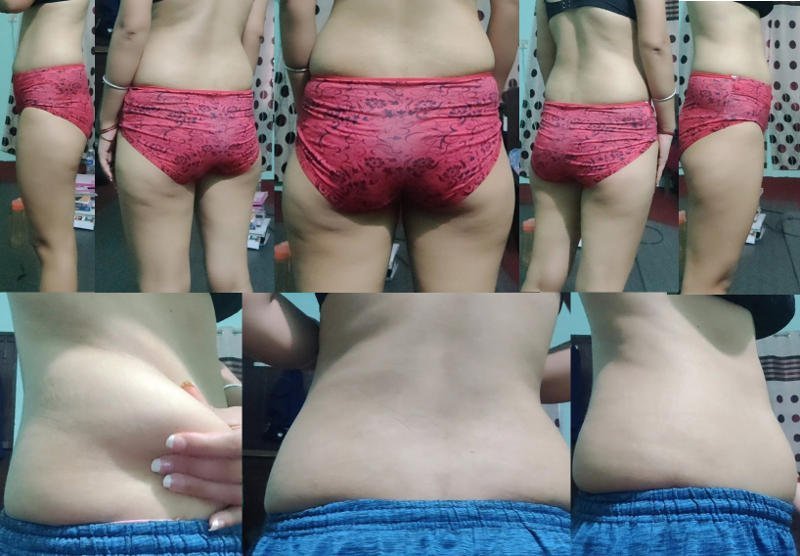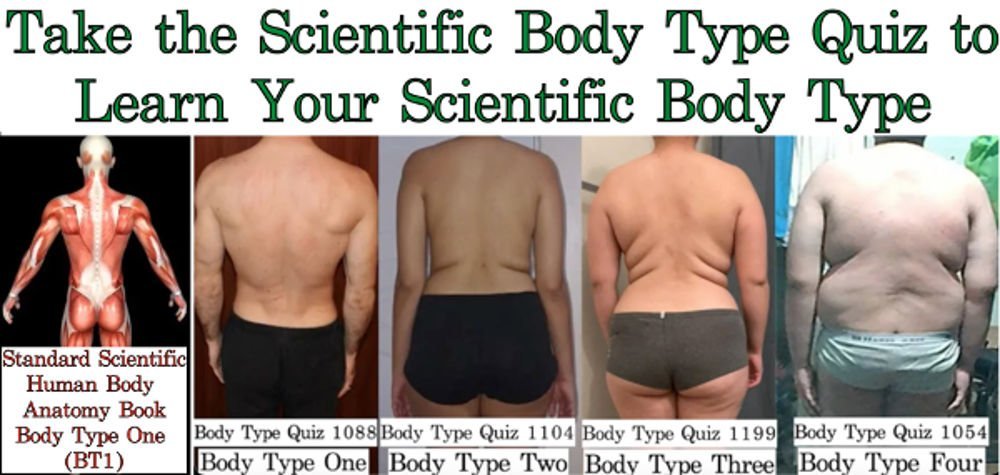

Body type science does not recognize the three body types (endomorph, ectomorph, mesomorph) as being real. Nor do mainstream science or medical doctors – they never have. The fact is, the only scientific body type that is actually recognized by mainstream science and medical doctors as being real is the Standard Scientific Human Body Anatomy Book Body Type One (BT1) found in any scientifically approved anatomy book.
It is the only scientifically accepted standard means of how to determine body type, hand-in-hand with the Standard Body Mass Index (BMI) and Standard Basal Metabolic Rate (BMR).
Unless a licensed medical doctor has diagnosed you with a specific malformation, abnormality, underdevelopment, or the like — such as Poland syndrome, scoliosis, etc. — you are a Standard Body Type One (BT1). Your body is “normal,” and therefore you have a normal BT1. According to mainstream medical doctors and scientists, the only reason your body does not look like a Standard BT1 (again, unless you have been diagnosed with an abnormality or the like) is that you are regularly eating too many calories daily above Standard BMR.
Body Type Science: Current Inaccurate Scientific Body Type Standards – Body Type One (BT1), Body Mass Index (BMI), & Basal Metabolic Rate (BMR)

By eating more calories daily than your Standard Basal Metabolic Rate (BMR, calculated via the Mifflin St Jeor equation and Harris-Benedict equation), which is the number of calories daily that are required for your specific body’s basic functioning, you are adding excess fat weight to your body. If that excss fat weight takes you outside your safe Standard Body Mass Index (BMI) weight range, you are overweight or obese. So long as you have been diagnosed as being normal, according to mainstream medical doctors and scientists, excess fat is the only reason why your body does not look like a Standard BT1.
To get your body to look like a Standard BT1 (once again, according to mainstream science and medical doctors), all you have to do is consistently maintain daily calorie consumption at or below your Mifflin St Jeor formula Standard BMR to burn off the excess fat. A 500-calorie per-day deficit below Standard BMR was the old standard for effective, successful weight loss. The new scientific standard is low-carb, calorie-valuable food.
You can also increase exercise activity to burn more calories, which is calculated through the Harris-Benedict formula.
Inaccurate Standard BMR – Skinny Fat
However, current Standard BMR formulas do not calculate skinny fat (thin fat, cellulite, crepey skin, loose skin, saggy skin, and/or normal weight obesity). Thus, for any person experiencing skinny fat, especially when within their safe Standard BMI, their Standard BMR is not accurate. This is because science recognizes that one pound of muscle burns six calories daily but one pound of skinny fat/fat only burns two to three calories.
Yet, again, mainstream scientists and medical doctors are adamant that once any excess fat weight has been burned off and you are within your safe Standard BMI weight range, if you are “normal” then your body is a Standard Body Type One (BT1) with all muscles, muscle mass, and posture (vertebrae/spinal extension) fully developed. They have no explanation for skinny fat in any form. The Standard Scientific Human Body Anatomy Book Body Type One (BT1) is the undisputed scientific body type standard. Along with the Standard BMI and Standard BMR, the Standard BT1 is the only scientific standard currently recognized by mainstream scientists and medical doctors.
Skinny Fat, Inaccurate Standard BT1 & Standard BMI – Body Type Science
But, there are millions upon millions upon millions of people in the world, no less, who, even when at the very bottom of their safe Standard BMI weight range, do not look like the Standard BT1. Instead of having fully developed muscles, muscle mass, and posture et al, they deal with skinny fat along with poor posture, no less, even when within safe BMI. They do not have a fully developed BT1. This is a second way that the scientific Standard BT1 along with the Standard BMI weight range scale are inaccurate.

It is a body type science fact that, genetically, any part of the human body can be underdeveloped or undeveloped, including muscles, muscle mass, and vertebrae (posture). For many people, the disease of obesity is directly related to genes/DNA. If obesity is a known genetic factor in your family, the probabilities increase that you are predisposed to being obese. This includes normal weight obesity, which is being obese/having too much fat on your body where there should be muscle(s)/mass even when within your safe Standard BMI weight range.
Body Type Science – Understanding Obesity, Muscle/Mass, & How Standard BMI is Further Inaccurate
It is a common misperception that obesity is defined as weighing too much/being overweight. The truth is, it is defined as having too much fat on your body. It is possible to add excess muscle weight alone to your body. Doing so can place you in the overweight or obese part of your Standard BMI weight range, outside the safe zone.
Dwayne Johnson “The Rock” is an example of being outside safe Standard BMI but not being overweight or obese. So long as you have properly added muscle/mass and NOT fat, even if you are outside your safe BMI weight range, you are technically NOT overweight or obese. This is another way that the Standard BMI weight scale is inaccurate.
How To Determine Body Type, The Four Body Types – Where Is The Muscle(s)?
 Fellow One Research’s The Four (4) Body Types science has been developed to offer more scientifically accurate body type identification tools. It uses well-established scientific variables including genetics/DNA, muscle(s), muscle mass, vertebrae (posture/spinal extension), skinny fat, fat, diet, exercise, metabolism/BMR, BMI, lifestyle, and the like. Until MRI (magnetic resonance imaging) machines become more cost-effective and readily available, the Scientific Body Type Quiz (Test) can accurately determine whether you are a Body Type One (BT1), Body Type Two (BT2), Body Type Three (BT3), or Body Type Four (BT4).
Fellow One Research’s The Four (4) Body Types science has been developed to offer more scientifically accurate body type identification tools. It uses well-established scientific variables including genetics/DNA, muscle(s), muscle mass, vertebrae (posture/spinal extension), skinny fat, fat, diet, exercise, metabolism/BMR, BMI, lifestyle, and the like. Until MRI (magnetic resonance imaging) machines become more cost-effective and readily available, the Scientific Body Type Quiz (Test) can accurately determine whether you are a Body Type One (BT1), Body Type Two (BT2), Body Type Three (BT3), or Body Type Four (BT4).
The Four Body Types Body Type Science has revolutionized scientific body types. By allowing the average person to actually scientifically understand how to determine your body type, you can better incorporate science-based diet, exercise, and lifestyle information to improve your overall health. Review the Body Type Science Research Data and FAQ as well as Celebrity Body Types information to learn more about The Four Body Types and how to determine your scientific body type.








